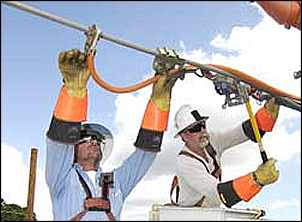Denver, Colorado [RenewableEnergyAccess.com]
In what could be the first example of
seamless integration between federal and state interconnection rules for
small generators, a wide cross-section of interests in Colorado have
filed with the state's public utility commission for the adoption of new
net-metering rules.
If passed, the measures would put Colorado on par with states like
New Jersey and Pennsylvania, which have high thresholds for the amount
of energy that can be generated from consumer- and business-sited
renewable energy systems, according to the Interstate Renewable Energy
Council (IREC).
As part of the implementation of Colorado's citizen-initiated renewable
portfolio standard (RPS), passed in November 2004 and known as Amendment
37, the state's utilities are required to adopt net metering and
interconnection standards.
During summer 2005, representatives from the Colorado environmental
community and renewable-energy community -- Colorado Solar Energy
Industries Association (CSEIA), the local American Solar Energy Society
(ASES) chapter, PV NOW and IREC -- met with utility representatives from
Xcel and Aquila to discuss implementation of Amendment 37. From these
discussions, the parties reached agreement on several key items for
implementation, including net metering and interconnection. However, the
parties did not reach agreement on other key program areas.
The parties submitted a consensus filing on August 15, 2005, to the
Colorado Public Utilities Commission (CPUC), indicating that the parties
had reached agreement on simplified net metering for commercial and
residential renewable-energy systems up to 2 megawatts (MW) in capacity.
Net metering -- available to solar, wind and other renewables -- would
involve a single, bi-directional meter if available under the customer's
tariff. Net excess generation (NEG) would be carried forward each month,
with an annual reconciliation at year's end. A customer-generator's
utility would provide a one-time meter change, if necessary to permit
net metering, but any additional meter changes would come at the
customer-generator's expense.
If the CPUC accepts the consensus filing, Colorado would join New Jersey
and Pennsylvania as the states with the highest limits for net metering
in the country. New Jersey has already implemented net metering rules
for systems up to 2 MW, while Pennsylvania statute implementing the
state's alternative energy portfolio standard (enacted in November 2004)
calls for a 2-MW limit on net metering.
Regarding interconnection, the Colorado consensus filing represents the
first state adoption of interconnection rules that largely follow the
Federal Energy Regulatory Commission's (FERC) recently promulgated
interconnection rules for small generators. Much of the interconnection
text is drawn directly from the FERC standard's language, including
provisions for inverter-based systems 10 kilowatts (kW) or less. In
addition, the expedited interconnection process for generators up to 2
MW in capacity is drawn largely from the FERC rules. Because the state
consensus relies on the FERC rules, Colorado would be the first state
with seamless integration between the federal interconnection rules and
the state interconnection rules for small generators.
The Colorado consensus filing improves on FERC's rules by clarifying the
procedures for interconnections to area and spot networks. It also
removes some ambiguity in the FERC rules regarding insurance, and
imposes an affirmative requirement that owners of distributed generation
must carry general liability insurance of at least $300,000 for
residential customers and $2,000,000 for commercial. No other specific
insurance is required.
In addition, the consensus filing includes provisions for a
dispute-resolution process. For more information on the consensus
filings, contact the Colorado PUC.
This article courtesy of the Interstate Renewable Energy Council (IREC)
